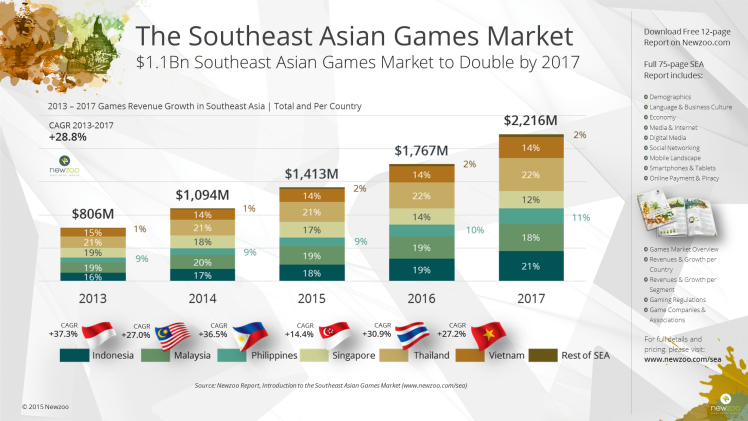Southeast Asia is one of the fastest-growing regions for gaming thanks to increased adoption of smartphones and movement to cities in countries like Indonesia and Malaysia, and the expansion is not slowing down.
Consumers in Indonesia, Malaysia, the Philippines, Singapore, Thailand, and Vietnam spent $1.1 billion on games in 2014, according to market-research firm Newzoo. The analysts at Newzoo expect the region to continue growing at a compound rate of around 28.8 percent, which would mean Southeast Asia will generate $2.2 billion in games spending by 2017. More than 626 million people live in the countries that make up Southeast Asia, but only 29 percent (179 million people) have access to the Internet. And among that group, gaming is one of the top activities. The global gaming industry has surpassed $93 billion, and developing nations will play a big part in that number growing past the $100 billion milestone in the future.
Newzoo has released a detailed report that goes into the habits and trends of the gamers in this territory, and it reveals who is spending money, and how it expects the region to grow.
“In 2014, these 60 million consumers spent an average of $18.40 on games totaling $1.1 billion,” reads the report. “These KPIs differ enormously per country in this very diverse region.”
Mobile developer or publisher?
Learn how the most successful developers get better users for less money.
Thailand is the top spender, and it will keep that title through 2017. Indonesia and Malaysia take second and third on that list, respectively.
One thing all of the countries of Southeast have in common is a population migration to cities. This trend will help increase spending as more people get access to the Web.
“The sheer size of the Southeast Asian population, and its rapid rate of urbanization of 1.4 percent average annual rate of change compared to China’s 0.5 percent, and its young and tech-savvy demographic, are all factors favorable for growth,” reads the report.
Population is a huge factor in Southeast Asia’s growing prominence in the world-gaming scene. Indonesia has 253 million people. Even with the country’s low Internet-access rate, it still has a bigger online population than any other country in the region just due to its size.
And while Indonesia, Malaysia, and the rest will probably continue to see a slow roll out of wired Internet, mobile is speeding up access like never before.
“Between 2004 and 2014, Internet access in the Philippines grew more than 800 percent, the fastest rate in the region,” the report says. “Due primarily to the boom in mobile internet.”
Naturally, that means developers looking to bring games to these countries should likely try to go mobile first. That strategy is already working.
“It is no surprise that mobile phone games are catching up with PC and MMO games in terms of revenues,” reads the report. “Vietnam is quickest on this trend, with mobile-phone games seeing a compound average growth rate from 2013 to 2017 of 87.7 percent, becoming the biggest segment in terms of revenues by 2017.”
Newzoo’s full report is available on its website, where it breaks down all of its data by country.
VentureBeat's mission is to be a digital town square for technical decision-makers to gain knowledge about transformative enterprise technology and transact. Learn More

